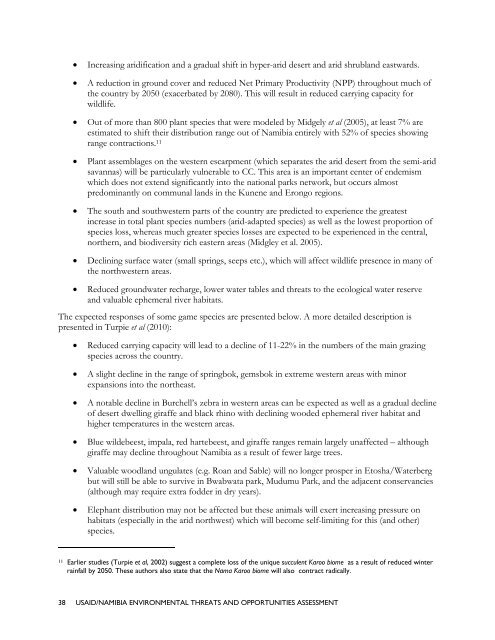usaid/nambia environmental threats and opportunities assessment
usaid/nambia environmental threats and opportunities assessment
usaid/nambia environmental threats and opportunities assessment
You also want an ePaper? Increase the reach of your titles
YUMPU automatically turns print PDFs into web optimized ePapers that Google loves.
Increasing aridification <strong>and</strong> a gradual shift in hyper-arid desert <strong>and</strong> arid shrubl<strong>and</strong> eastwards.<br />
A reduction in ground cover <strong>and</strong> reduced Net Primary Productivity (NPP) throughout much of<br />
the country by 2050 (exacerbated by 2080). This will result in reduced carrying capacity for<br />
wildlife.<br />
Out of more than 800 plant species that were modeled by Midgely et al (2005), at least 7% are<br />
estimated to shift their distribution range out of Namibia entirely with 52% of species showing<br />
range contractions. 11<br />
Plant assemblages on the western escarpment (which separates the arid desert from the semi-arid<br />
savannas) will be particularly vulnerable to CC. This area is an important center of endemism<br />
which does not extend significantly into the national parks network, but occurs almost<br />
predominantly on communal l<strong>and</strong>s in the Kunene <strong>and</strong> Erongo regions.<br />
The south <strong>and</strong> southwestern parts of the country are predicted to experience the greatest<br />
increase in total plant species numbers (arid-adapted species) as well as the lowest proportion of<br />
species loss, whereas much greater species losses are expected to be experienced in the central,<br />
northern, <strong>and</strong> biodiversity rich eastern areas (Midgley et al. 2005).<br />
Declining surface water (small springs, seeps etc.), which will affect wildlife presence in many of<br />
the northwestern areas.<br />
<br />
Reduced groundwater recharge, lower water tables <strong>and</strong> <strong>threats</strong> to the ecological water reserve<br />
<strong>and</strong> valuable ephemeral river habitats.<br />
The expected responses of some game species are presented below. A more detailed description is<br />
presented in Turpie et al (2010):<br />
<br />
<br />
<br />
<br />
<br />
<br />
Reduced carrying capacity will lead to a decline of 11-22% in the numbers of the main grazing<br />
species across the country.<br />
A slight decline in the range of springbok, gemsbok in extreme western areas with minor<br />
expansions into the northeast.<br />
A notable decline in Burchell’s zebra in western areas can be expected as well as a gradual decline<br />
of desert dwelling giraffe <strong>and</strong> black rhino with declining wooded ephemeral river habitat <strong>and</strong><br />
higher temperatures in the western areas.<br />
Blue wildebeest, impala, red hartebeest, <strong>and</strong> giraffe ranges remain largely unaffected – although<br />
giraffe may decline throughout Namibia as a result of fewer large trees.<br />
Valuable woodl<strong>and</strong> ungulates (e.g. Roan <strong>and</strong> Sable) will no longer prosper in Etosha/Waterberg<br />
but will still be able to survive in Bwabwata park, Mudumu Park, <strong>and</strong> the adjacent conservancies<br />
(although may require extra fodder in dry years).<br />
Elephant distribution may not be affected but these animals will exert increasing pressure on<br />
habitats (especially in the arid northwest) which will become self-limiting for this (<strong>and</strong> other)<br />
species.<br />
11 Earlier studies (Turpie et al, 2002) suggest a complete loss of the unique succulent Karoo biome as a result of reduced winter<br />
rainfall by 2050. These authors also state that the Nama Karoo biome will also contract radically.<br />
38 USAID/NAMIBIA ENVIRONMENTAL THREATS AND OPPORTUNITIES ASSESSMENT

















